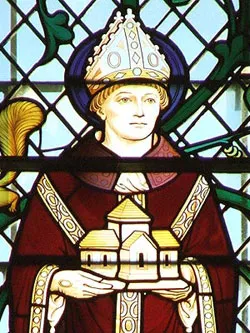SAINT MARK

SAINT MARK
Saint Mark’s mother was a prominent member of the infant Church at Jerusalem; it was to her house that Peter turned on his release from prison; the house was approached by a porch there was a slave girl to open the door and the house was a meeting place for the brethren, “many” of whom were praying there the night Saint Peter arrived from prison (Acts, xii, 12-13).
When, on the occasion of the famine of A.D. 45-46, Barnabas and Saul had completed their ministration in Jerusalem, they took Mark with them on their return to Antioch (Acts, xii, 25). The context of Acts, xiii, 5, suggests that he
helped even in preaching the Word. When Paul and Barnabas resolved to push on from Perga into central Asia Minor, Mark, departed from them and returned to Jerusalem (Acts, xiii, 13). What his reasons were for turning back, we cannot day with certainty; Acts, xv, 38, seems to suggest that he feared the toil. At any
rate, the incident was not forgotten by Saint Paul, who refused on account of it to take Mark with him on the second Apostolic journey. This refusal led to the
separation of Paul and Barnabas, and the latter, taking Mark with him, sailed to Cyprus (Acts, xv, 37-40). At this point (A.D. 49-50) we lose sight of Mark in Acts, and we meet him no more in the New Testament, till he appears some ten years afterwards as the fellow worker of Saint Paul, and in the company of Saint Peter, at Rome.
Saint Paul, writing to the Colossians during his first Roman imprisonment (A.D. 59-61), says: “Aristarchus, my fellow prisoner, saluteth you, and Mark, the cousin of Barnabas, touching whom you have received commandments; if he come unto you, receive him” (Col., iv, 10).
The Evangelist’s intention of visiting Asia Minor was probably carried out, for Saint Paul, writing shortly before his death to Timothy at Ephesus, bids him pick up Mark and bring him with him to Rome, adding “for he is profitable to me for the ministry” (II Tim., iv, 11). If Mark came to Rome at this time, he was probably there when Saint Paul was martyred.
Saint Mark had been the interpreter (hermeneutes) of Peter, and wrote down
accurately, though not in order, the teaching of Peter. A widespread, if somewhat late, tradition represents Saint Mark as the founder of the Church of Alexandria. The “Martyrologium Romanum” (25 April) records: “At Alexandria the anniversary of Blessed Mark the Evangelist . . . at Alexandria of Saint Anianus Bishop, the disciple of Blessed Mark and his successor in the episcopate, who fell asleep in the Lord.” The date at which Mark came to Alexandria is uncertain. The Chronicle of Eusebius assigns it to the first years of Claudius and later on states that Saint Mark’s first successor, Anianus,
succeeded to the See of Alexandria in the eighth year of Nero . This would make Mark Bishop of Alexandria for a period of about twenty years. This is
not impossible, if we might suppose in accordance with some early evidence that Saint Peter came to Rome in A.D. 42, Mark perhaps accompanying him. But Acts raise considerable difficulties. On the assumption that the founder of the Church of Alexandria was identical with the companion of Paul and Barnabas, we find him at Jerusalem and Antioch about A.D. 46 (Acts xii, 25), in
Salamis about 47 (Acts, xiii, 5), at Antioch again about 49 or 50 (Acts, xv, 37-9), and when he quitted Antioch, on the separation of Paul and Barnabas, it was
not to Alexandria but to Cyprus that he turned (Acts, xv, 39).
The date of Mark’s death is uncertain. Saint Jerome (“De Vir. Illustr.”, viii) assigns it to the eighth year of Nero (62-63) (Mortuus est octavo Neronis anno et sepultus Alexandriæ), but this is probably only an inference from the statement of Eusebius (“Hist. eccl.”, II, xxiv), that in that year Anianus succeeded St. Mark in the See of Alexandria. Certainly, if Saint Mark was alive when II. Timothy was written (II Tim., iv, 11), he cannot have died in 61-62. Nor does Eusebius say he did; the historian may merely mean that Saint Mark then resigned his see, and left Alexandria to join Peter and Paul at Rome. As to the manner of his death, the “Acts” of Mark give the saint the glory of martyrdom, and say that he died while being dragged through the streets of Alexandria.
rosary.team
















